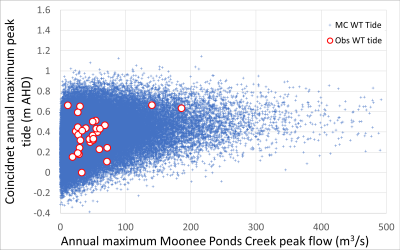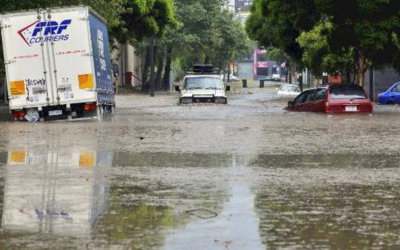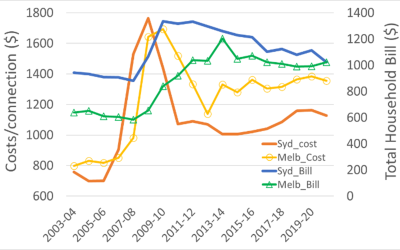Introduction
A systems approach is used to explore the solutions that become available when the constraints imposed by institutionalisation of urban water cycle management are removed. There are many hidden or lost opportunities in urban water cycle management that are manifested in source control techniques. The opportunities created by the use of source control measures are discussed. This thesis describes the development and performance of two demonstration sites that use source control measures for water conservation and stormwater management. The knowledge gained from these sites is employed to develop methods for the analysis of the impact of rainwater tanks used as source control measures at the allotment, subdivision and regional scales. A number of case studies are used to demonstrate the benefits of rainwater tanks at the three scales.
Chapter 2 describes the development, monitoring and performance of the Figtree Place experiment in Newcastle, Australia. Figtree Place is a 27-unit medium density development that uses infiltration, groundwater and roof water reuse methods for stormwater management and water conservation. The objective of the Figtree Place experiment was to develop an understanding of the design, social, institutional, water quality, maintenance andwater use issues that result from the use of source control measures.
Chapter 3 discusses the development, monitoring and performance of the Maryville retrofit site. The knowledge gained from the Figtree Place experiment was used to install a rainwater tank to supply hot water, toilet and outdoor uses to an existing house on a small allotment in the inner city of Newcastle adjacent to a heavy industry area. The Maryville site was monitored for economic and social impact, water quality and use. The objective of the Maryville site experiment was to develop understanding of the performance of a rainwater tank at the single allotment scale.
Chapter 4 examines the water quality results from the Figtree Place and Maryville sites in the context of Australian Standards and public health policies. An analysis of historical rainwater quality, health risks and different water use scenarios is presented. The objective is to provide an understanding of the dynamics of roof, tank and hot water service rainwater quality and to present a case for acceptable rainwater reuse scenarios.
Chapter 5 explores the operation of the stormwater disposal and water supply paradigms, and the institutional resistance to the use of rainwater tanks. There is significant institutional resistance to the use of rainwater tanks in the stormwater disposal and water supply industries. This resistance often manifests itself in the guise of health and economic concerns.
Chapter 6 describes the development of an allotment water balance model to assess water conservation and stormwater management scenarios. The model operates at sub minute time scales to allow investigation of infrastructure alternatives and includes a new probabilistic behavioral outdoor water use model. The allotment water balance model is used to evaluate the performance of rainwater tanks at the allotment and cluster scale in a number of case studies. The objective of the allotment water balance model is to enable comparison of source control techniques at a time scale that will allow assessment of the impact on infrastructure provision and to allow understanding of the performance of source control measures.
Chapter 7 develops a method of analysing the performance of source control methods in subdivisions. The method uses the allotment water balance model discussed in Chapter 6 and the WUFS (Water Urban Flow Simulator) model developed by Kuczera et al. [2000]. Two case studies compare the economic, stormwater management and water conservation performance of WSUD measures (including source controls) against traditional development approaches. The objective of this chapter is to allow understanding of the impact of source control measures at the subdivision scale.
Chapter 8 introduces a new method for the estimation of regional water demand that incorporates the allotment water balance model discussed in Chapter 6 and the method of estimating non-domestic water use developed by Kuczera and Ng [1994]. The new regional demand method accounts for the water use habits at the allotment scale and allows evaluation of the impact of demand management methods including rainwater tanks. Two regional case studies are presented to demonstrate the efficacy of rainwater tanks in the management of regional water demand. The objective of the regional demand model is to include demand management measures such as rainwater tanks in a systems analysis of regional water demand.
Chapter 9 presents a case study of the Lower Hunter region’s water supply system that is primarily reliant on surface and aquifer storages to provide adequate drought security. The introduction of rainwater tanks to supplement domestic mains water supply creates significant delays in the need to augment water supply infrastructure. The extent of this benefit to the community is examined. A case study of the Central Coast region’s water supply system that is heavily reliant on stream diversions is also presented.
Chapter 10 discusses water supply and stormwater management economics. An investment model is developed to allow comparison between source control methods and traditional approaches at the allotment, subdivision and regional scale. A number of case studies from the previous Chapters are examined to compare the economic benefits of source control measures to traditional approaches.
Chapter 11 provides the conclusions derived from this investigation and recommends future research directions that result from this study.
Cartoon by John Spooner of The Age in the article by Dr Peter Coombes (27 August 1998) “Don’t knock tank power”





